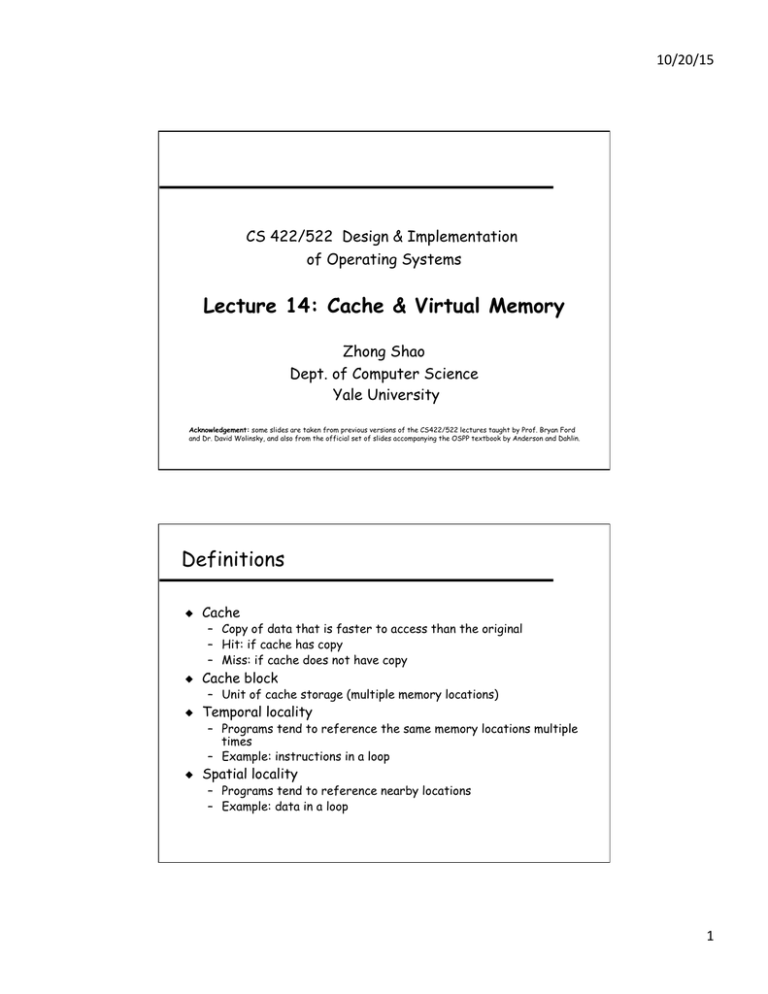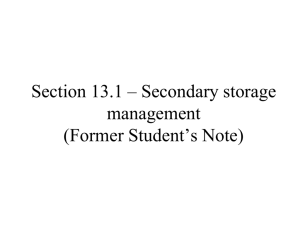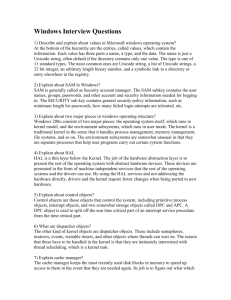Document 10733344
advertisement

10/20/15 CS 422/522 Design & Implementation
of Operating Systems
Lecture 14: Cache & Virtual Memory
Zhong Shao
Dept. of Computer Science
Yale University
Acknowledgement: some slides are taken from previous versions of the CS422/522 lectures taught by Prof. Bryan Ford
and Dr. David Wolinsky, and also from the official set of slides accompanying the OSPP textbook by Anderson and Dahlin.
Definitions
◆
Cache
– Copy of data that is faster to access than the original
– Hit: if cache has copy
– Miss: if cache does not have copy
◆
Cache block
◆
Temporal locality
– Unit of cache storage (multiple memory locations)
– Programs tend to reference the same memory locations multiple
times
– Example: instructions in a loop
◆
Spatial locality
– Programs tend to reference nearby locations
– Example: data in a loop
1 10/20/15 Cache concept (read)
Cache
Fetch
Address
Address In
Cache?
No
Fetch
Address
Yes
Store Value
in Cache
Cache concept (write)
Cache
Store Value
at Address
Store Value
at Address
Address In
Cache?
No
Fetch
Address
WriteBuffer
Yes
Write through: changes sent
immediately to next level of
storage
Write back: changes stored in
cache until cache block is
replaced
Store Value
in Cache
If Write Through
Store Value
at Address
2 10/20/15 Memory hierarchy
i7 has 8MB as shared 3rd level cache; 2nd level cache is per-core
Main points
◆
Can we provide the illusion of near infinite memory in
limited physical memory?
– Demand-paged virtual memory
– Memory-mapped files
◆
How do we choose which page to replace?
– FIFO, MIN, LRU, LFU, Clock
◆
What types of workloads does caching work for, and
how well?
– Spatial/temporal locality vs. Zipf workloads
3 10/20/15 Hardware address translation is a power tool
◆
Kernel trap on read/write to selected addresses
–
–
–
–
–
–
–
Copy on write
Fill on reference
Zero on use
Demand paged virtual memory
Memory mapped files
Modified bit emulation
Use bit emulation
Demand paging (before)
Page Table
Frame
Virtual Page B Frame for B
Physical Memory
Page Frames
Access
Disk
Page A
Page B
Invalid
Page A
Virtual Page A Frame for A
R/W
4 10/20/15 Demand paging (after)
Page Table
Frame
Virtual Page B Frame for B
Physical Memory
Page Frames
Access
Disk
Page A
Page B
R/W
Page B
Virtual Page A Frame for A
Invalid
Demand paging
1.
2.
3.
4.
5.
6.
7.
TLB miss
Page table walk
Page fault (page
invalid in page table)
Trap to kernel
Convert virtual
address to file +
offset
Allocate page frame
–
Evict page if needed
8.
9.
10.
11.
12.
13.
Disk interrupt when
DMA complete
Mark page as valid
Resume process at
faulting instruction
TLB miss
Page table walk to
fetch translation
Execute instruction
Initiate disk block
read into page frame
5 10/20/15 Demand paging on MIPS (software TLB)
1.
2.
3.
4.
5.
6.
7.
TLB miss
Trap to kernel
Page table walk
Find page is invalid
Convert virtual
address to file +
offset
Allocate page frame
–
8.
9.
10.
11.
12.
Disk interrupt when
DMA complete
Mark page as valid
Load TLB entry
Resume process at
faulting instruction
Execute instruction
Evict page if needed
Initiate disk block
read into page frame
Allocating a page frame
◆
◆
Select old page to evict
Find all page table entries that refer to old page
– If page frame is shared
◆
◆
Set each page table entry to invalid
Remove any TLB entries
– Copies of now invalid page table entry
◆
Write changes on page back to disk, if necessary
6 10/20/15 How do we know if page has been modified?
◆
Every page table entry has some bookkeeping
– Has page been modified?
* Set by hardware on store instruction
* In both TLB and page table entry
– Has page been recently used?
* Set by hardware in page table entry on every TLB miss
◆
Bookkeeping bits can be reset by the OS kernel
– When changes to page are flushed to disk
– To track whether page is recently used
Keeping track of page modifications (before)
TLB
Frame
Page Table
Access
Dirty
R/W
No
Frame
Access
Physical Memory
Page Frames
Disk
Old Page A
Dirty
Old Page B
Virtual Page B
Frame for B
Invalid
Page A
Virtual Page A
Frame for A
R/W
No
7 10/20/15 Keeping track of page modifications (after)
TLB
Frame
Page Table
Access
Dirty
R/W
Yes
Frame
Access
Physical Memory
Page Frames
Disk
Old Page A
Dirty
Old Page B
Virtual Page B
Frame for B
Invalid
New Page A
Virtual Page A
Frame for A
R/W
Yes
Virtual or physical dirty/use bits
◆
Most machines keep dirty/use bits in the page table entry
◆
Physical page is
– modified if any page table entry that points to it is modified
– recently used if any page table entry that points to it is recently
used
◆
On MIPS, simpler to keep dirty/use bits in the core map
– Core map: map of physical page frames
8 10/20/15 Emulating a modified bit (Hardware Loaded TLB)
◆
Some processor architectures do not keep a modified
bit per page
– Extra bookkeeping and complexity
◆
Kernel can emulate a modified bit:
–
–
–
–
◆
Set all clean pages as read-only
On first write to page, trap into kernel
Kernel sets modified bit, marks page as read-write
Resume execution
Kernel needs to keep track of both
– Current page table permission (e.g., read-only)
– True page table permission (e.g., writeable, clean)
Emulating a recently used bit (Hardware Loaded TLB)
◆
Some processor architectures do not keep a recently
used bit per page
– Extra bookkeeping and complexity
◆
Kernel can emulate a recently used bit:
–
–
–
–
◆
Set all recently unused pages as invalid
On first read/write, trap into kernel
Kernel sets recently used bit
Marks page as read or read/write
Kernel needs to keep track of both
– Current page table permission (e.g., invalid)
– True page table permission (e.g., read-only, writeable)
9 10/20/15 Emulating modified/use bits w/
MIPS software-loaded TLB
◆
MIPS TLB entries have an extra bit: modified/unmodified
– Trap to kernel if no entry in TLB, or if write to an unmodified page
◆
On a TLB read miss:
– If page is clean, load TLB entry as read-only; if dirty, load as rd/wr
– Mark page as recently used
◆
On a TLB write to an unmodified page:
– Kernel marks page as modified in its page table
– Reset TLB entry to be read-write
– Mark page as recently used
◆
On TLB write miss:
– Kernel marks page as modified in its page table
– Load TLB entry as read-write
– Mark page as recently used
Models for application file I/O
◆
Explicit read/write system calls
–
–
–
◆
Data copied to user process using system call
Application operates on data
Data copied back to kernel using system call
Memory-mapped files
–
–
–
–
Open file as a memory segment
Program uses load/store instructions on segment memory,
implicitly operating on the file
Page fault if portion of file is not yet in memory
Kernel brings missing blocks into memory, restarts process
10 10/20/15 Advantages to memory-mapped Files
◆
Programming simplicity, esp for large files
– Operate directly on file, instead of copy in/copy out
◆
Zero-copy I/O
– Data brought from disk directly into page frame
◆
Pipelining
– Process can start working before all the pages are populated
◆
Interprocess communication
– Shared memory segment vs. temporary file
From memory-mapped files to demand-paged
virtual memory
◆
Every process segment backed by a file on disk
–
–
–
–
–
◆
Code segment -> code portion of executable
Data, heap, stack segments -> temp files
Shared libraries -> code file and temp data file
Memory-mapped files -> memory-mapped files
When process ends, delete temp files
Unified memory management across file buffer and
process memory
11 10/20/15 Cache replacement policy
◆
On a cache miss, how do we choose which entry to
replace?
– Assuming the new entry is more likely to be used in the near
future
– In direct mapped caches, not an issue!
◆
Policy goal: reduce cache misses
– Improve expected case performance
– Also: reduce likelihood of very poor performance
A simple policy
◆
Random?
– Replace a random entry
◆
FIFO?
– Replace the entry that has been in the cache the longest time
– What could go wrong?
12 10/20/15 FIFO in action
Worst case for FIFO is if program strides
through memory that is larger than the
cache
MIN, LRU, LFU
◆
MIN
– Replace the cache entry that will not be used for the longest
time into the future
– Optimality proof based on exchange: if evict an entry used
sooner, that will trigger an earlier cache miss
◆
Least Recently Used (LRU)
– Replace the cache entry that has not been used for the
longest time in the past
– Approximation of MIN
◆
Least Frequently Used (LFU)
– Replace the cache entry used the least often (in the recent
past)
13 10/20/15 LRU/MIN for sequential scan
14 10/20/15 More page frames → fewer page faults?
◆
Consider the following reference string with 3 page
frames
– FIFO replacement
– A, B, C, D, A, B, E, A, B, C, D, E
– 9 page faults!
◆
Consider the same reference string with 4 page frames
– FIFO replacement
– A, B, C, D, A, B, E, A, B, C, D, E
– 10 page faults
◆
This is called Belady’s anomaly
Belady’s anomaly (cont’d)
15 10/20/15 Clock algorithm
◆
◆
◆
Approximate LRU
Replace some old page, not the oldest unreferenced page
Arrange physical pages in a circle with a clock hand
– Hardware keeps “use bit” per physical page frame
– Hardware sets “use bit” on each reference
– If “use bit” isn’t set, means not referenced in a long time
◆
0
On page fault:
–
–
–
–
Advance clock hand
Check “use bit”
If “1” clear, go on
If “0”, replace page
1
1
1
1
0
0
0
1
1
1
1
Nth chance: Not Recently Used
◆
Instead of one bit per page, keep an integer
– notInUseSince: number of sweeps since last use
◆
Periodically sweep through all page frames
if (page is used) {
notInUseSince = 0;
} else if (notInUseSince < N) {
notInUseSince++;
} else {
reclaim page;
}
16 10/20/15 Implementation note
◆
Clock and Nth Chance can run synchronously
– In page fault handler, run algorithm to find next page to evict
– Might require writing changes back to disk first
◆
Or asynchronously
– Create a thread to maintain a pool of recently unused, clean
pages
– Find recently unused dirty pages, write mods back to disk
– Find recently unused clean pages, mark as invalid and move to
pool
– On page fault, check if requested page is in pool!
– If not, evict that page
Recap
◆
MIN is optimal
– replace the page or cache entry that will be used farthest into
the future
◆
LRU is an approximation of MIN
– For programs that exhibit spatial and temporal locality
◆
Clock/Nth Chance is an approximation of LRU
– Bin pages into sets of “not recently used”
17 10/20/15 How many pages allocated to each process ?
◆
◆
Each process needs minimum number of pages.
Example: IBM 370 – 6 pages to handle SS MOVE
instruction:
– instruction is 6 bytes, might span 2 pages.
– 2 pages to handle from.
– 2 pages to handle to.
◆
Two major allocation schemes.
– fixed allocation
– priority allocation
Fixed allocation
◆
◆
Equal allocation – e.g., if 100 frames and 5
processes, give each 20 pages.
Proportional allocation – Allocate according to
the size of process.
si = size of process pi
S = ∑ si
m = total number of frames
ai = allocation for pi =
si
×m
S
m = 64
s1 = 10
s2 = 127
10
× 64 ≈ 5
137
127 × ≈
a2 =
64 59
137
a1 =
18 10/20/15 Priority allocation
◆
◆
Use a proportional allocation scheme using priorities
rather than size.
If process Pi generates a page fault,
– select for replacement one of its frames.
– select for replacement a frame from a process with lower
priority number.
Global vs. local allocation
◆
◆
Global replacement – process selects a replacement
frame from the set of all frames; one process can take
a frame from another.
Local replacement – each process selects from only its
own set of allocated frames.
19 10/20/15 What to do when not enough memory?
◆
Thrashing: processes on system require more memory
than it has.
P3
P2
P1
Real mem
* Each time one page is brought in, another page, whose contents will soon be
referenced, is thrown out.
* Processes will spend all of their time blocked, waiting for pages to be
fetched from disk
* I/O devices at 100% utilization but system not getting much useful work
done
◆
◆
What we wanted: virtual memory the size of disk with access
time of physical memory
What we have: memory with access time = disk access
Thrashing
◆
Process(es) “frequently”reference page not in mem
– Spend more time waiting for I/O then getting work done
◆
Three different reasons
– process doesn’t reuse memory, so caching doesn’t work
– process does reuse memory, but it does not “fit”
P1
mem
– individually, all processes fit and reuse memory, but too many
for system.
◆
Which can we actually solve?
20 10/20/15 Making the best of a bad situation
◆
Single process thrashing?
– If process does not fit or does not reuse memory, OS can do
nothing except contain damage.
◆
System thrashing?
– If thrashing arises because of the sum of several processes
then adapt:
* figure out how much memory each process needs
* change scheduling priorities to run processes in groups whose memory
needs can be satisfied (shedding load)
* if new processes try to start, can refuse (admission control)
Working set model
◆
◆
◆
Working Set: set of memory locations that need
to be cached for reasonable cache hit rate
Size of working set = the important threshold
The size may change even during execution of the
same program.
21 10/20/15 Cache working set
100%
Hit Rate
75%
50%
25%
0%
1
2
4
8
16
Cache Size (KB)
Phase change behavior
100%
Hit Rate
75%
50%
25%
0%
Time
22 10/20/15 Question
◆
What happens to system performance as we increase
the number of processes?
– If the sum of the working sets > physical memory?
Zipf distribution
◆
◆
Caching behavior of many systems are not well
characterized by the working set model
An alternative is the Zipf distribution
– Popularity ~ 1/k^c, for kth most popular item,
1<c<2
– “frequency inversely proportional to its rank in the frequency
table (e.g., frequency word in English natural language)
* Rank 1: “the”
* Rank 2: “of”
* Rank 3: “and”
7% (69,971 out of 1 million in “Brown Corpus”)
3.5% (36,411 out of 1 million)
2.3% (28,852 out of 1 million)
23 10/20/15 Popularity
Zipf distribution
1
k
Rank
Zipf examples
Web pages
◆ Movies
◆ Library books
◆ Words in text
◆ Salaries
◆ City population
◆ …
Common thread: popularity is self-reinforcing
◆
24 10/20/15 Zipf and caching
Cache Hit Rate
1
0
.01%
.001%
.1%
1%
10%
all
Cache Size (Log Scale)
Increasing the cache size continues to improve cache hit rates, but
with diminishing returns
Cache lookup: fully associative
address
address
value
=?
=?
=?
=?
match at any address?
yes
return value
25 10/20/15 Cache lookup: direct mapped
address
value
=?
match at hash(address)?
hash(address)
yes
return value
Cache lookup: set associative
address
value
address
value
hash(address)
0x0053
=?
0x120d
match at hash(address)?
yes
return value
=?
match at hash(address)?
yes
return value
26 10/20/15 Page coloring
◆
What happens when cache size >> page size?
– Direct mapped or set associative
– Multiple pages map to the same cache line
◆
OS page assignment matters!
– Example: 8MB cache, 4KB pages
– 1 of every 2K pages lands in same place in cache
◆
What should the OS do?
Page coloring
Memory
Processors
Virtual
Address
O
Address
Mod K
Cache
K
2K
3K
27







